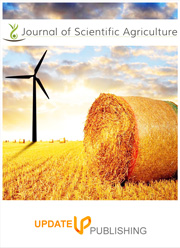Application of Principal Component Analysis to advancing digital phenotyping of plant disease in the context of limited memory for training data storage
DOI:
https://doi.org/10.25081/jsa.2023.v7.8327Keywords:
PCA, Image reconstruction, Storage space optimization, Guava image classificationAbstract
Despite its widespread employment as a highly efficient dimensionality reduction technique, limited research has been carried out on the advantage of Principal Component Analysis (PCA)–based compression/reconstruction of image data to machine learning-based image classification performance and storage space optimization. To address this limitation, we designed a study in which we compared the performances of two Convolutional Neural Network-Random Forest Algorithm (CNN-RF) guava leaf image classification models developed using training data from a number of original guava leaf images contained in a predefined amount of storage space (on the one hand), and a number of PCA compressed/reconstructed guava leaf images contained in the same amount of storage space (on the other hand), on the basis of four criteria – Accuracy, F1-Score, Phi Coefficient and the Fowlkes–Mallows index. Our approach achieved a 1:100 image compression ratio (99.00% image compression) which was comparatively much better than previous results achieved using other algorithms like arithmetic coding (1:1.50), wavelet transform (90.00% image compression), and a combination of three transform-based techniques – Discrete Fourier (DFT), Discrete Wavelet (DWT) and Discrete Cosine (DCT) (1:22.50). From a subjective visual quality perspective, the PCA compressed/reconstructed guava leaf images presented almost no loss of image detail. Finally, the CNN-RF model developed using PCA compressed/reconstructed guava leaf images outperformed the CNN-RF model developed using original guava leaf images by 0.10% accuracy increase, 0.10 F1-Score increase, 0.18 Phi Coefficient increase and 0.09 Fowlkes–Mallows increase.
Downloads
References
Alsayyh, M. M., Mohamad, D., Saba, T., Rehman, A., & AlGhamdi, J. S. (2017). A Novel Fused Image Compression Technique Using DFT, DWT, and DCT. Journal of Information Hiding and Multimedia Signal Processing, 8(2), 261-271.
Asnaoui, K. E. (2020). Image Compression Based on Block SVD Power Method. Journal of Intelligent Systems, 29(1), 1345-1359. https://doi.org/10.1515/jisys-2018-0034
Balle, J., Laparra, V., & Simoncelli, E. P. (2017). End-To-End Optimized Image Compression. 5th International Conference on Learning Representations (pp. 1-27). arXiv. https://doi.org/10.48550/arXiv.1611.01704
Chouhan, S. S., Singh, U. P., Kaul, A., & Jain, S. (2019, November 21-22). A Data Repository of Leaf Images: Practice towards Plant Conservation with Plant Pathology. 4th International Conference on Information Systems and Computer Networks (ISCON) (pp. 700-707). IEEE. https://doi.org/10.1109/ISCON47742.2019.9036158
Du, B., Duan, Y., Zhang, H., Tao, X., Wu, Y., & Ru, C. (2022). Collaborative image compression and classification with multi-task learning for visual Internet of Things. Chinese Journal of Aeronautics, 35(5), 390-399. https://doi.org/10.1016/j.cja.2021.10.003
Dutta, S., Abhinav, A., Dutta, P., Kumar, P., & Halder, A. (2012). An Efficient Image Compression Algorithm Based on Histogram Based Block Optimization and Arithmetic Coding. International Journal of Computer Theory and Engineering, 4(6), 954-957. https://doi.org/10.7763/IJCTE.2012.V4.614
Fu, D., & Guimaraes, G. (2016, December 10). Using Compression to Speed up Image Classification in Artificial Neural Networks. Cambridge, Massachusetts, USA.
Guo, T., Wang, J., Cui, Z., Feng, Y., Ge, Y., & Bai, B. (2020, June 14-19). Variable Rate Image Compression with Content Adaptive Optimization. IEEE/CVF Conference on Computer Vision and Pattern Recognition Workshops (CVPRW) (pp. 4321-4325). IEEE. https://doi.org/10.1109/CVPRW50498.2020.00069
Helminger, L., Djelouah, A., Gross, M., & Schroers, C. (2021). Lossy Image Compression with Normalizing Flows. Neural Compression Workshop (pp. 1-10). arXiv. https://doi.org/10.48550/arXiv.2008.10486
Husseen, A. H., Mahmud, S. S., & Mohammed, R. J. (2017). Image Compression Using Proposed Enhanced Run Length Encoding Algorithm. Ibn Al-Haitham Journal for Pure and Applied Sciences, 24(1), 1-14. https://doi.org/10.30526/24.1.803
Karthikeyan, N., Saravanakumar, N. M., & Sivakumar, M. (2021). Fast and efficient lossless encoder in image compression with low computation and low memory. IET Image Processing, 15(11), 2494-2507. https://doi.org/10.1049/ipr2.12235
Krishnan, K. S., Jaison, B., & Raja, S. P. (2020). Secured Color Image Compression Based on Compressive Sampling and Lü System. Information Technology and Control, 49(3), 346-369. https://doi.org/10.5755/j01.itc.49.3.25901
Lammi, J., & Sarjakoski, T. (1995). Image Compression by the JPEG Algorithm. Photogrammetric Engineering & Remote Sensing, 61(10), 1261-1266.
Maldjian, J. A., Liu, C. W., Hirschorn, D., Murthy, R., & Semanczuk, W. (1997). Wavelet Transform-Based Image Compression for Transmission of MR data. American Journal of Roentgenology, 169(1), 23-26. https://doi.org/10.2214/ajr.169.1.9207495
Mohsen, A., & Tiwari, M. (2021). Image Compression and Classification Using Qubits and Quantum Deep Learning. arXiv. https://doi.org/10.48550/arXiv.2110.05476
Nagashree, G., Gadre, V., & Vijaya, S. M. (2014). Lossless Medical Image Compression. International Journal of Engineering Research and Applications, 4(6), 7-11.
Nasiriany, S., Thomas, G., Wang, W., Yang, A., Listgarten, J., & Sahai, A. (2019). A Comprehensive Guide to Machine Learning. Berkeley, USA: University of California.
Nesteruk, S., Shadrin, D., Pukalchik, M., Somov, A., Zeidler, C., Zabel, P., & Schubert, D. (2021). Image Compression and Plants Classification Using Machine Learning in Controlled-Environment Agriculture: Antarctic Station Use Case. IEEE Sensors Journal, 21(16), 1-9. https://doi.org/10.1109/JSEN.2021.3050084
Parmar, C. K., & Pancholi, K. (2016). A review on image compression techniques. Journal of Information, Knowledge and Research in Electrical Engineering, 2(2), 281-284.
Poolakkachalil, T. K., & Chandran, S. (2019). Summative Stereoscopic Image Compression using Arithmetic Coding. Indonesian Journal of Electrical Engineering and Informatics, 7(3), 564-576. https://doi.org/10.52549/ijeei.v7i3.755
Rahman, A., Hamada, M., & Rahman, A. (2022). A comparative analysis of the state-of-the-art lossless image compression techniques. The 4th ETLTC International Conference on ICT Integration in Technical Education (ETLTC2022). https://doi.org/10.1051/shsconf/202213903001
Taoufiq, S. (2016). Image Compression Using Discrete Wavelet Transforms. Morocco: Al Akhawayn University.
Tellez, D., Hoppener, D., Verhoef, C., Grunhagen, D., Nierop, P., Drozdzal, M., Laak, J. van der, & Ciompi, F. (2020). Extending Unsupervised Neural Image Compression With Supervised Multitask Learning. Proceedings of Machine Learning Research. arXiv. https://doi.org/10.48550/arXiv.2004.07041
Yang, E.-H., Amer, H., & Jiang, Y. (2021). Compression Helps Deep Learning in Image Classification. Entropy, 23(7), 881. https://doi.org/10.3390/e23070881
Published
How to Cite
Issue
Section
Copyright (c) 2023 Enow Takang Achuo Albert, Ngalle Hermine Bille, Ngonkeu Mangaptche Eddy Leonard

This work is licensed under a Creative Commons Attribution-NonCommercial-NoDerivatives 4.0 International License.



 .
.